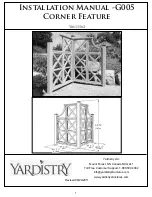
www.NakayamaTools.com
11
If contact accidentally occurs, flush with water. If liquid contacts eyes,
additionally seek
medical help
.
Liquid ejected from the battery may cause irritation or burns.
6)
Service
a)
Have your power tool serviced by a qualified repair person using only identical
replacement parts
.
This will ensure that the safety of the power tool is maintained.
Additional safety instructions for battery
and
charger
Battery
The battery fluid, a 25
-
30% solution of potassium hydroxide, can be
harmful. In case of skin
contact, immediately rinse with water.
Neutralize with a mild acid such as lemon juice or
vinegar. In case of eye contact, rinse abundantly with clean water for at least 10 minutes.
Consult a physician.
The battery is not fully charged when you first receive it. First read the safety instructions
below the follow charging notes and procedures.
READ ALL INSTRUCTIONS CAREFULLY AND KEEP IN A SAFE PLACE FOR FUTURE
REFERENCE.
1. Do not incinerate the battery even if it is severely
damaged or is completely worn out.
The battery can explode in a fire.
2.
A small leakage of liquid from the battery cells may occur under extreme usage or
temperature conditions. This does not indicate a failure. However, if the outer seal is broken
and this leakage gets on your skin:
a.
Wash quickly with soap and water.
b.
Neutralize with a mild acid such as lemon juice or vinegar.
c.
If battery liquid gets in your eyes, flush them with clean water for a minimum of minutes
and seek immediate medical attention. (Medical notes: the liquid is 25
-
35% solution of
potassium hydroxide.)
3.
Do not connect the positive pole and the negative pole of the battery with any
metal
objects. Battery could be short circuited causing damage to the battery and possibly causing
severe burns or fire.
4.
Charge the battery only in the chargers supplied with the product.
5.
NOTE: The battery
in your tool is
the Lithium
-
ion
type, with no self
-
discharge or memory
effect.
Charger
·
Charger’s plug must match the outlet. Never modify the plug in any way.
Unmodified
plugs and matching outlets will reduce risk of electric shock
.
·
Use your charger only to charge batteries of the type supplied with your tool. Other
batteries could burst, causing personal injury and damage.
·
Only 2 battery packs is allowed to be charged continuously in order to prevent
overheating of charger, necessary rest time is required to let the charger cool down before
further charging.
·
When charging is finished, unplug the charger from mains socket outlet and take away
the battery pack from the charger, do not leave the battery pack in the charger.
·
Never carry the charger by its cord or pull it to disconnect from the socket.
Keep the cord
away from heat, oil and sharp edges
.



































